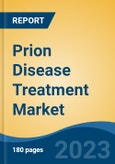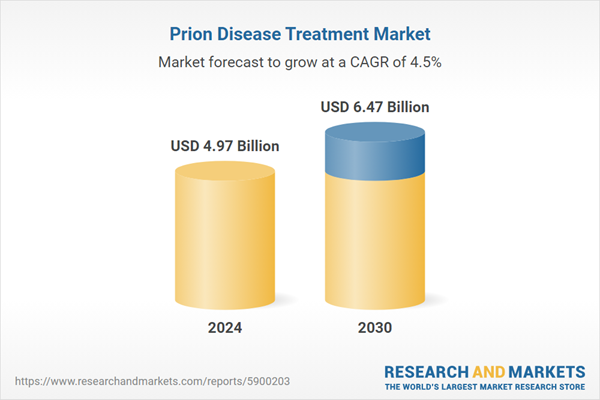Speak directly to the analyst to clarify any post sales queries you may have.
10% Free customizationThis report comes with 10% free customization, enabling you to add data that meets your specific business needs.
The market is witnessing steady expansion, supported by greater disease awareness, improved diagnostics, and increased research initiatives aimed at developing effective therapies. While no cure exists, current treatment approaches are largely supportive, focusing on symptom management and patient quality of life. Human prion diseases are the dominant segment, driven by higher prevalence and research activity. Antidepressants represent the leading drug class due to their role in managing neurological and psychiatric symptoms. Innovations in biomarker research, funding for neurodegenerative studies, and exploration of advanced therapeutic methods are expected to further propel market growth, despite challenges such as diagnostic complexity, low incidence rates, and limited treatment options.
Key Market Drivers
Increasing Prevalence of Prion Diseases
The rising incidence of prion diseases globally is a major growth driver for the treatment market. These neurodegenerative disorders, though rare, are increasingly diagnosed due to advancements in medical technology and growing awareness among healthcare professionals. Enhanced diagnostic capabilities have made it possible to identify cases that were previously misdiagnosed or undetected, contributing to a perceived rise in prevalence.Additionally, the aging global population has amplified the incidence of diseases like sporadic CJD, which is more common in older adults. According to the National Library of Medicine, at least 485 cases of iatrogenic CJD (iCJD) have been documented worldwide, most of which occurred prior to 2012. These included cases linked to contaminated surgical tools, EEG needles, corneal transplants, and notably, human-derived growth hormones and dura mater grafts. As detection improves and awareness increases, the demand for prion disease treatments is expected to grow steadily.
Key Market Challenges
Limited Understanding of Prion Diseases
A major challenge hindering the development of effective prion disease therapies is the limited understanding of the diseases' underlying mechanisms. Prion disorders are complex, and their pathogenesis - particularly how prions replicate and cause neurodegeneration - remains only partially understood. This knowledge gap restricts the identification of viable drug targets and slows down therapeutic innovation. The intricacy of prion biology requires extensive research to unravel molecular pathways before advancing drug discovery. This lack of foundational understanding poses a significant barrier to the timely development and approval of effective treatments.Key Market Trends
Emerging Therapeutic Approaches
Innovative treatment strategies are emerging as key trends in the prion disease treatment landscape. Researchers are investigating a range of novel approaches to halt or reverse disease progression.- Small molecules are being developed to disrupt prion replication and reduce neurotoxicity.
- Monoclonal antibodies are being explored for their potential to bind and neutralize misfolded prion proteins.
- RNA-based therapies, such as antisense oligonucleotides (ASOs) and RNA interference (RNAi), aim to suppress abnormal prion protein production or promote its breakdown.
- Gene therapy techniques, including CRISPR-Cas9, show promise for correcting genetic mutations responsible for inherited prion disorders.
Key Players Profiled in this Prion Disease Treatment Market Report
- Fresenius SE & Co. KGaA
- Elite Pharmaceuticals Inc
- Ionis Pharmaceuticals Inc
- Novartis AG
- Merck KGaA
- AstraZeneca PLC
- Bristol-Myers Squibb Company
- Cipla Ltd
- Teva Pharmaceuticals
- Abbott Laboratories
Report Scope:
In this report, the Global Prion Disease Treatment Market has been segmented into the following categories, in addition to the industry trends which have also been detailed below:Prion Disease Treatment Market, by Type:
- Human Prion Diseases
- Animal Prion Diseases
Prion Disease Treatment Market, by Drug:
- Antidepressant
- Antipsychotic Agents
Prion Disease Treatment Market, by Region:
- North America
- United States
- Canada
- Mexico
- Europe
- France
- United Kingdom
- Italy
- Germany
- Spain
- Asia-Pacific
- China
- India
- Japan
- Australia
- South Korea
- South America
- Brazil
- Argentina
- Colombia
- Middle East & Africa
- South Africa
- Saudi Arabia
- UAE
Competitive Landscape
Company Profiles: Detailed analysis of the major companies present in the Global Prion Disease Treatment Market.Available Customizations:
With the given market data, the publisher offers customizations according to a company's specific needs. The following customization options are available for the report.Company Information
- Detailed analysis and profiling of additional market players (up to five).
This product will be delivered within 1-3 business days.
Table of Contents
Companies Mentioned
The leading companies profiled in this Prion Disease Treatment market report include:- Fresenius SE & Co. KGaA
- Elite Pharmaceuticals Inc
- Ionis Pharmaceuticals Inc
- Novartis AG
- Merck KGaA
- AstraZeneca PLC
- Bristol-Myers Squibb Company
- Cipla Ltd
- Teva Pharmaceuticals
- Abbott Laboratories
Table Information
| Report Attribute | Details |
|---|---|
| No. of Pages | 180 |
| Published | May 2025 |
| Forecast Period | 2024 - 2030 |
| Estimated Market Value ( USD | $ 4.97 Billion |
| Forecasted Market Value ( USD | $ 6.47 Billion |
| Compound Annual Growth Rate | 4.4% |
| Regions Covered | Global |
| No. of Companies Mentioned | 11 |









